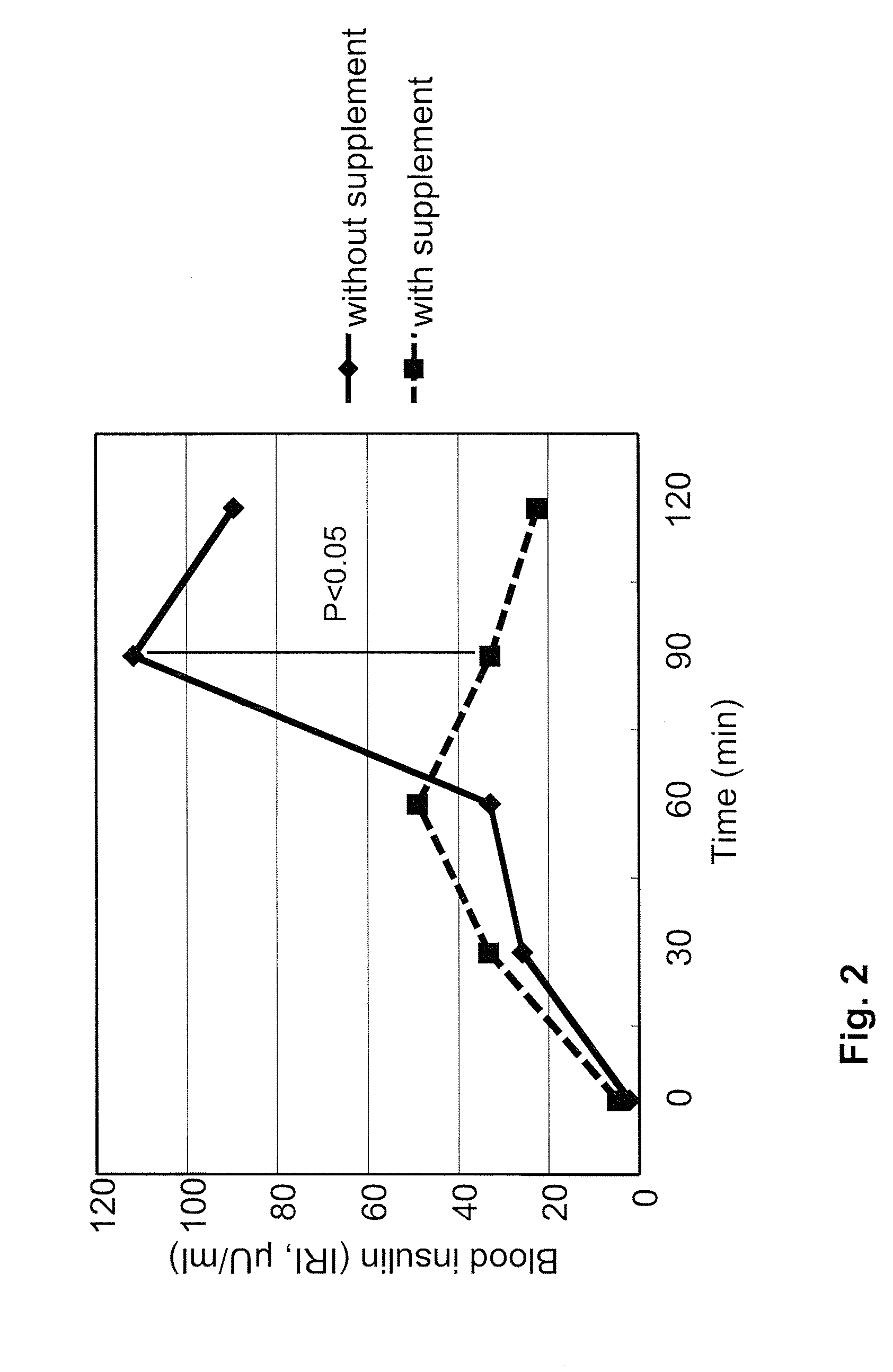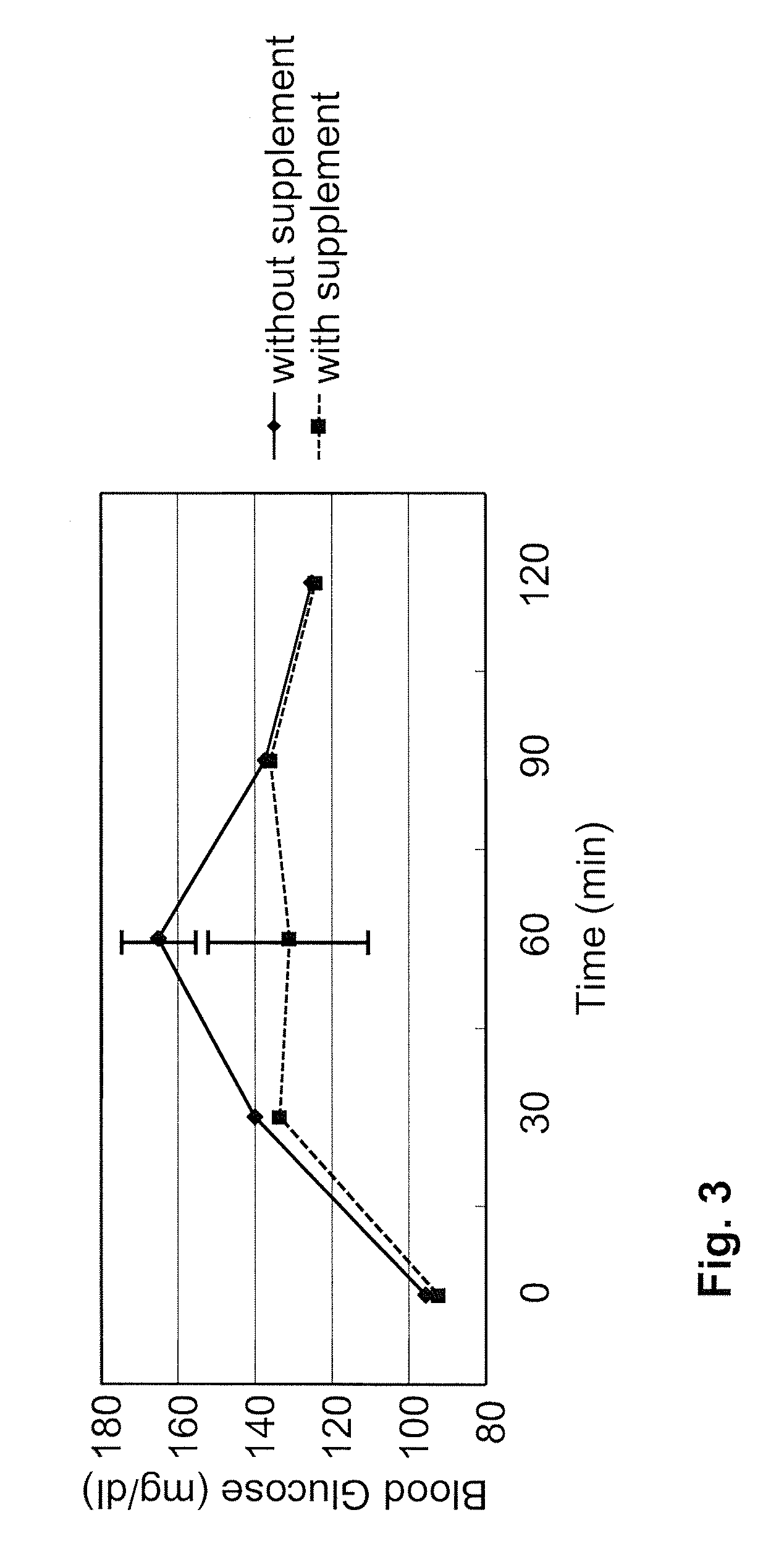Compositions and uses thereof
a technology of compositions and compounds, applied in the field of compositions and uses thereof, can solve the problems of increased risk of cardiovascular diseases, increased risk of erectile dysfunction (impotence), and long-term complications of health risks, and achieve the effects of less insulin in the blood, less blood glucose levels, and less health risks
- Summary
- Abstract
- Description
- Claims
- Application Information
AI Technical Summary
Benefits of technology
Problems solved by technology
Method used
Image
Examples
example 1
Supplement and Volunteers
[0100]A supplement was prepared by mixing together one gram of vitamin C, 1.5 gram of glutamic acid, 500 mg of cysteine, 40 mg of riboflavin, 100 mg of succinic acid, 100 mg of fumaric acid, and 10 mg of niacin, and 250 mg of AQUAQ10P40 (100 mg of coenzyme Q10). All ingredients of the supplement, except coenzyme Q10, were purchased from Sigma Aldrich Japan (Tokyo, Japan). AQUAQ10P40 (Nissin Pharma, Tokyo Japan), which contains 40% by volume of coenzyme Q10, was used as coenzyme Q10. In the experiments for the comparison of the effects of glutamic acid and glutamine, glutamine was used in the supplement instead of glutamic acid in an analogous manner. The supplement was taken by the volunteers with 100 ml water 20 minutes before starting the oral glucose tolerance test.
[0101]Four volunteers, age 26-48 years old (average 38 years old), weight 45-75 kg (average 62 kg), two female and two male participated in the experiments. All volunteers were confirmed by blo...
example 2
Oral Glucose Tolerance Test (OGTT) and Snack Bread Test
[0105]For the snack bread test, one bread with adzuki paste and one with sweet cream per volunteer were used. Total nutrition facts of two breads were: calories: 780 Kcal, protein: 20 gram, fat: 18 gram, carbohydrate: 130 gram. Two snack breads were eaten by each volunteer within 10 minutes, and blood sampling was performed at the same time points as described in Example 1. Statistical analysis of the results was conducted by t2 test, and p<0.5 was defined as the level of significance. The effects of the supplement on blood glucose and insulin levels in the snack bread experiments are shown in FIGS. 3 and 4, respectively (IRI: immunoreactive insulin). Consistent with the OGTT results in Example 1, the supplement provided the same advantageous effects to the volunteers when consuming more complex food: Blood glucose peaks were reduced, blood glucose was cleared earlier from the blood, and less insulin was needed for glucose clear...
example 3
Comparison of Supplement Containing L-Glutamic Acid or L-Glutamine
[0107]To examine whether it makes any difference in effect on OGTT glucose degradation if L-glutamic acid or L-glutamine is used in the supplement, L-glutamine was used instead of L-glutamic acid in the supplement in some tests. Blood glucose and IRI was monitored in these glutamine mix experiments as well. Statistical analysis of the results was conducted by t2 test, and p<0.5 was defined as the level of significance.
[0108]A comparison of the effects of supplement containing L-glutamic acid or L-glutamine mixture on blood glucose and insulin levels is shown in FIGS. 5 and 6, respectively (IRI: immunoreactive insulin; Glutamine mix: supplement with glutamine but without glutamic acid; Glutamic acid mix: supplement with glutamic acid but without glutamine; Control: OGTT without prior administration of supplement). While the supplement including glutamine instead of glutamic acid seemed not to be as effective on absolut...
PUM
| Property | Measurement | Unit |
|---|---|---|
| weight | aaaaa | aaaaa |
| weight | aaaaa | aaaaa |
| body weight | aaaaa | aaaaa |
Abstract
Description
Claims
Application Information
 Login to View More
Login to View More - R&D
- Intellectual Property
- Life Sciences
- Materials
- Tech Scout
- Unparalleled Data Quality
- Higher Quality Content
- 60% Fewer Hallucinations
Browse by: Latest US Patents, China's latest patents, Technical Efficacy Thesaurus, Application Domain, Technology Topic, Popular Technical Reports.
© 2025 PatSnap. All rights reserved.Legal|Privacy policy|Modern Slavery Act Transparency Statement|Sitemap|About US| Contact US: help@patsnap.com



